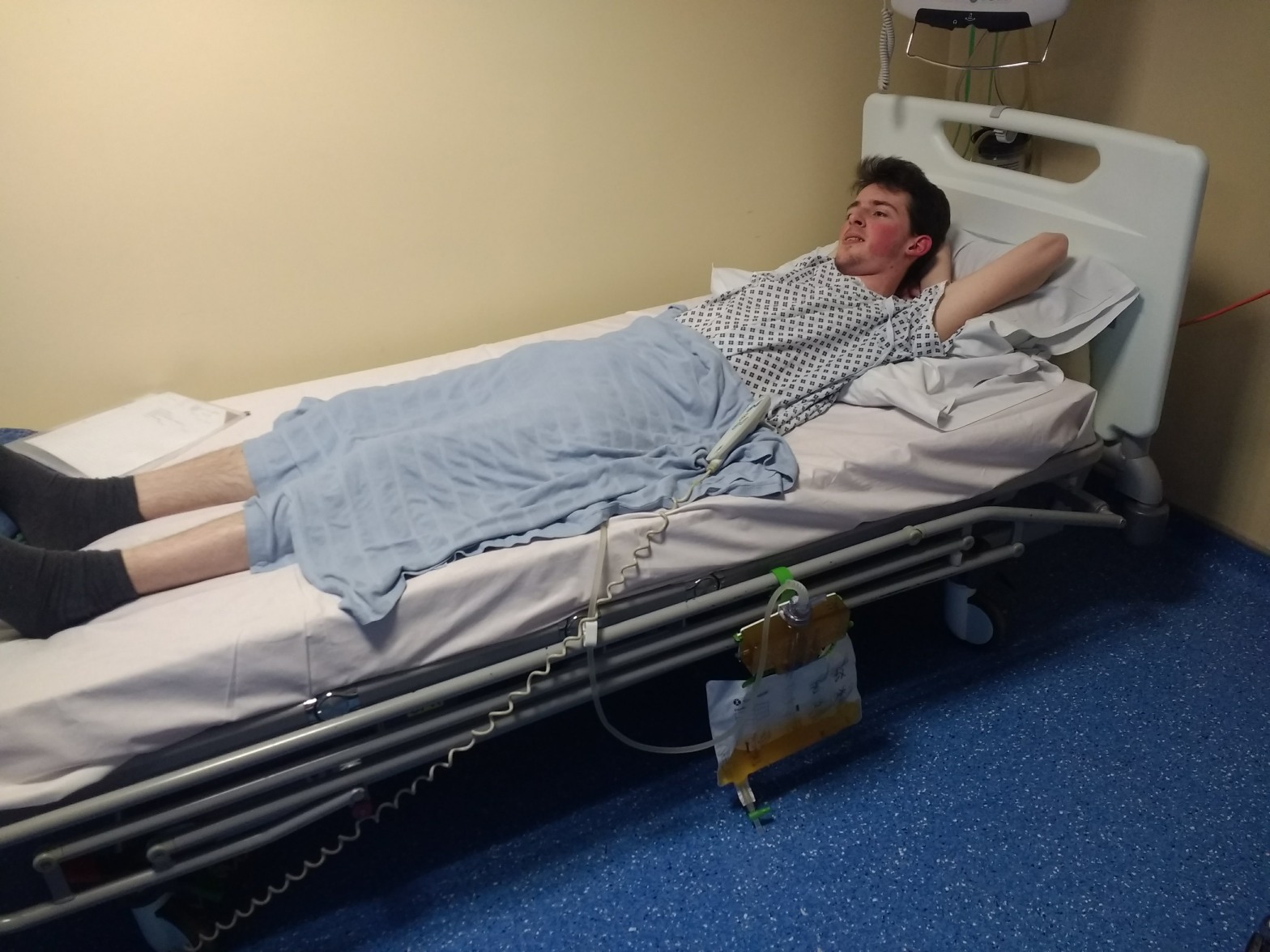New Years Eve 2017 and Laurence presented at A&E with full urine retention. Following triage and an hour or so wait, I asked his symptoms be looked at urgently. They responded and Laurence had 1700mls of urine drained from his bladder by catheter. The regular (and to be expected) questions were asked regarding sexual activity, injury etc. No reason was found for the retention, he was catheterised and sent home during the early hours of New Year’s Day. At this point came our first re-assurance that it wouldn’t be anything serious. The A&E doctor on duty examined him fully and referred him to urology. His appointment would be in about five weeks’ time to give his bladder muscles time to re-strengthen and try without catheter.
His first urology appointment was on 5th February 2018. He was seen by the Urology Nurse Practitioner who did as we expected, tried without catheter (TWOC) to no avail as Laurence still couldn’t pass anything. Again we were asked had he sustained any injuries in the past or did we have any ideas about why this had come about. May be he was simply holding on to his pee for too long before going? Laurence politely said he wasn’t and explained the pain clearly, citing it as coming from the area of his prostate. He was re-catheterised upon which the staff nurse treating him noticed a blockage around his urethra. This was noted as an obstruction and Laurence was offered a further appointment for a procedure called urodynamics. Again, re-assurances were made that it would not be serious. Still in considerable pain Laurence opted to miss out on a university educational trip to Athens to take a cancelled appointment for this investigation on the 15th February – quicker than they had expected to happen. No stones, no infection, no answers – but still, apparently, wouldn’t be serious. Laurence left catheterised again. At this point further investigation through the regular channels was being prepared, but with no urgency; all in a regular time scale, the department was after all very busy. As time pressed on Laurence experienced more acute pain. He had returned to university as he so wanted to not have to re-sit his final year. He soldiered on with friends shopping for him and giving him lifts from his house to lectures. His pain became so bad that he found it almost unbearable to walk just between lectures on campus, and sitting in a lecture theatre very uncomfortable. Later in February I got a call saying he’d presented at the university medical centre complaining of pain in his back and around the area of his kidneys. The university GP offered to call Laurence an ambulance and have him admitted to their local hospital A&E, but Laurence opted for me to pick him up and take him back to his local hospital where he believed, as he’d already been there would have a case history they could follow. The university GP prepared a supporting letter for the A&E department detailing Laurence’s latest symptoms and a positive sample for urine infection that morning. Laurence was seen again, Oramorph was not giving him any pain relief and he explained clearly the pain in his back and region of his kidneys. Bloods were taken, urine re-sampled and showed no infection come the afternoon, and an A&E nurse said to him ‘Since when can’t a GP deal with a kidney infection?’. Laurence was ‘in luck’ apparently as there was a urologist available in A&E at this time. The urologist came to the cubicle Laurence was in and without even drawing the curtain, said to me ‘It will be stones’. I explained that Urodynamics had already been done and as far as I understood no stones were found. Now drawing back the curtain to meet Laurence, he said he could put him forward for a CT scan, and he could request it be on the 2 week fast track – however, it wouldn’t be serious and probably the wait for the scan would be more like 4 weeks.
Another night of excruciating pain and the next morning Laurence and I visited his local GP during a drop in clinic. She re-tested Laurence’s urine and found it is was positive for infection, as it had been 24 hours earlier. She was not happy with the blood results taken at A&E the previous day, and said she could see Laurence ‘isn’t the kind of young man to be making this up’. Upon sending him to pathology for further blood tests there and then, she also advised me to chase up the urology department to speed along the CT scan – something she as a GP couldn’t do as it was not ‘etiquette’.
While Laurence was having his bloods taken I rang the Urology Nurse Practitioner to explain the latest developments and request the CT scan be brought forward – apparently something the Nurse Practitioner couldn’t do because it wasn’t her department/place to pressure them and she wouldn’t be able to have any sway over them.
The pain continued and Laurence’s blood results were returned to his local GP who called me to explain she’d requested – indeed had to apply pressure – for Laurence to be admitted as an in-patient and further tests to be run, alongside having him CT scanned ASAP. Laurence and I literally couldn’t wait to get there and we arrived by 07.30am the next morning, desperate to ensure he got booked in for a scan that day -and he did. By this point Laurence was now completely constipated as well as still catheterised and his pain was still not being touched by Oramorph. The scan results showed him to be extremely constipated and there was blood in his bladder making it difficult to see, so probably another attempt at taking a look at it with him sedated was needed. He was given a number of enemas and allowed home the next evening.
Another appalling night of pain and by 12 noon the next day I had taken him back to A&E. The triage nurse acknowledged in words that it had been a failed discharge, but whether or not it was noted as such I don’t know. Being a Sunday the A&E doctor on duty called the Urology consultant on call who agreed to admit Laurence and see him the next morning. Three further days went by with Laurence’s pain worsening and him literally screaming out in agony. One morning during a ward round by the duty consultant Laurence let out his frustration – why had his notes not been consistent, why were some missing between A&E and the ward, and what was yet known of what was actually wrong with him? The Consultant’s response was Laurence had some blood in his urine, the pain should be bearable and that he was going to be discharged again that day.
At this point I felt beyond despair and consulted our local GP who couldn’t intervene as Laurence was under the care of the hospital, however she explained I could refuse his discharge. I did so and also contacted the Patient Liaison Service (PALS).
A junior doctor took the time to collate Laurence’s notes and for the first time he felt there was a full and proper track record.
Eventually bloods showed both his kidneys were failing and he was taken for a surgical procedure to fit double nephrostomies (kidney drains directly out of his back). A combination of the pain and emotional trauma had left Laurence in a terrible state and he spent the night distraught with other patients calling the nurses to him.
I was called to meet the consultant urologist who, along with a ward sister, took me to an office. The CT scan had been reviewed and they’d this time seen a growth not previously noticed, the size of a large orange – on his prostate. It was now mid-March 2018, and it would be a further two weeks for biopsy results to be returned from the Royal Marsden.
The day of the diagnosis came around and Laurence and I were asked to meet with the urologist at 12.30. Again, we were taken to a side room and this time two ward sisters attended. The result of the biopsy was Rhabdomysarcoma – a rare and aggressive cancer, but none the less a cancer, that had started in his prostate. The Urologist said ‘I’m sorry, we were looking in the wrong place’.
At the beginning of April 2018 Laurence was transferred to the Teenage and Young Adults Unit at Southampton University Hospital where for the following 7 months he received the most outstanding treatment and care. By the time he arrived with them his tumour was deemed ‘huge’ and measured 12cms in diameter. It had reached his pelvis and had metastasised, with spots on his lungs.
Laurence fought a courageous 7 months battle before passing away on the 8th November 2018.







